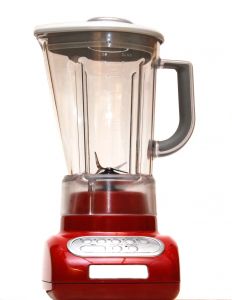By Amanda Hughes, co-leader for API of St. Louis, Missouri, USA
 When my sister was a baby, I remember my mom had a food mill at the table and she would feed the same food to my sister that we ate for supper. It seemed easy to me, at four years old.
When my sister was a baby, I remember my mom had a food mill at the table and she would feed the same food to my sister that we ate for supper. It seemed easy to me, at four years old.
Years later, during my baby shower, my friends and I played a game that changed the way I would feed my children. I took ten jars of baby food, and the women had to guess what each was. They could smell, look, taste, touch – anything they wanted, to try to guess it. I look back at this and remember how we laughed when we got them wrong. I particularly remember how bad the meats smelled and how that made me nervous: What is in this stuff? Do I want to feed this to my child? Can I blame them if they don’t want to eat this?
When it was time to start solids with my daughter Josie, I was very excited. I found a website that I continue to follow, WholesomeBabyFood.com, where I learned a few of the advantages in making my own baby food, including:
- The great financial benefit – It was easy to find the cost difference: 1 to 4 cents per ounce for homemade baby food, and 17 to 23 cents per ounce for jarred.
- Knowing what’s going into my babies – There is a report about all the fillers that are added to the jarred baby food, some of which may cause allergic reactions, to stretch manufacturers’ profit margins. By making my own baby food, I choose the quality of the fruits and veggies that my baby eats. In my opinion, the quality is better for much less money.
- Easy transition for babies – It’s easier for children to move from baby food to finger food to table food if it is the same. I can control the consistency, so instead of following Gerber or another manufacturer’s stages, I follow my children’s lead. I make food thicker or chunkier as I see they like it and can safely gum and swallow it. And, by making my own baby food, my children are eating the same things that the rest of the family is eating. This starts in utero: I like Mexican food, so they tasted the spice in the womb. After birth, they tasted it in breastmilk and later, they were introduced to the new food textures with the same flavor until they were eating the same foods as the rest of the family.
- Easy for me – I make vegetables for dinner, save some that are free of butter and seasoning for the baby, and throw it into the food processor to prepare as baby food. The same with sweet potatoes: I cook up two or three sweet potatoes, save some to be made into baby food, and my husband and I eat the rest.
- Knowing what my babies can eat – If certain foods are introduced too early, the more likely children can become allergic to them. The website suggests foods to start with and at what age, along with warnings on what not to introduce.
So, how did baby food making work for me? Well, I thought it was easy, and I would suggest it to any new or experienced mom.
One steamed zucchini makes a lot of baby food, especially with the leftover water added. I then add rice or oatmeal cereal to it to thicken it up. I use the commercial baby cereals, as I know they are iron-fortified, which is good since I nursed. (There are differing opinions on this, which I respect, but this was my choice.)
I save the leftover brown rice and introduce that in the foods when the babies get older and can handle the texture. I sometimes use a bit of leftover chicken or beef, the rice, and a vegetable to make a little casserole. It was all the same foods we ate, so we didn’t waste anything.
I remember how I thought baby food making was so easy with Josie. She started solids at six months old, and I have pictures of her eating finger foods at eight months old, so of course, less than two months of making baby food was easy with Josie! My son Asher, born two years later, was different. He is my snuggler. He continued with baby foods until he was well over a year old, and didn’t want to do finger foods.
Josie is still an excellent fruit and vegetable eater. She will eat an entire steamed yellow squash for breakfast if I let her. But I have to watch her and make sure she gets protein in her diet. Asher took a bit of a different path. He just finished a stage where he had his favorites and wouldn’t eat other things. For example, he would eat a whole butternut squash in 24 hours but skip peas. We are now entering a new stage where he is starting to realize that all these great summer fruits and vegetables are pretty good, so he gets all excited with new things – foods that are new to his memory, but really since I just weaned him, they are the same flavors he has always loved.